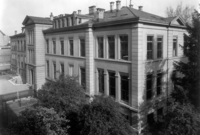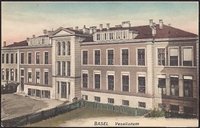The Vesalianum
Built in 1884/85 between the Spalenvorstadt and the Old Arsenal on St. Peter’s Square and named after the anatomist Andreas Vesal, the Vesalianum first housed research and teaching in anatomy and physiology. Vesal had come to Basel to oversee the publication of his famous book of anatomical plates De humaniscorpora fabrica (which appeared with Oporin in 1542), conducting an equally famous public dissection of a human corpse in the city.
As with the construction of the Bernoullianum, half of the construction costs were covered by the Voluntary Academic Society. Wilhelm His, still responsible for both anatomy and physiology, rejoiced at the opening ceremony on 28 May 1885: “As a new addition, the Vesalianum joins the circle of those Basel institutions that owe their existence to the beautiful collaboration of state support and private sacrifice.” The building would become an important site for the work of (Johannes) Friedrich Miescher(1844–1895), known for discovering nucleic acid. Miescher was appointed professor of physiology in 1871 and founded the first Physiological Institute in Switzerland, located at the Vesalianum.
The building served its original purpose for some four decades, until the Anatomical Institute moved into a new building in the district of St. Johann in 1921. In the following years, the Institute of Physiology had to share the Vesalianum with the newly created Institute of Physiological Chemistry, later called the Institute of Biochemistry (established in 1921), and the Institute of Pharmacology (established in 1922). In 1931, a unit for researching vitamins was also established at the site. Spatial improvements came in 1941 with the relocation of the pharmacologists to the central hospital complex, where they remained until their move in 1972 to the Biozentrum (Center for Molecular Life Sciences), and with the addition to the Vesalianum begun and completed in 1967.
During the construction work on the Vesalianum in 1884/85, remains of the first Jewish cemetery in Basel came to light; a total of twenty graves were uncovered at the site. The cemetery was first mentioned in documents in 1264 but was devastated during the Basel Jewish pogroms of 1348/49. Hundreds of gravestones were removed at the time and reused as building materials. During the demolition of the Old Arsenal and the construction of the Kollegienhaus, further graves containing 150 skeletons came to light, along with 10 gravestones and 25 gravestone fragments.




